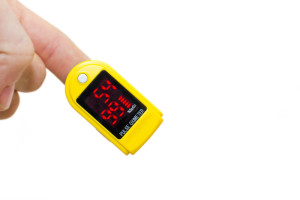 The six minute walk test is a simple test measuring how far a patient can walk in six minutes. The test is a quick, non-invasive, inexpensive, radiation free way to monitor how well a patient is doing. The test can also be used to determine if an Idiopathic Pulmonary Fibrosis patient needs oxygen when they are active. The test may be performed in your physician’s office, hospital or pulmonary rehab facility. The walk course is usually in a hallway at least 50 ft in length with 100ft being optimal. Markers are placed every 10ft to easily measure distance. It is important to find a place for the track that is either isolated and quiet or can be blocked off. Once the test begins it is important to avoid interruptions such as talking, walking around obstacles or avoiding people.
The six minute walk test is a simple test measuring how far a patient can walk in six minutes. The test is a quick, non-invasive, inexpensive, radiation free way to monitor how well a patient is doing. The test can also be used to determine if an Idiopathic Pulmonary Fibrosis patient needs oxygen when they are active. The test may be performed in your physician’s office, hospital or pulmonary rehab facility. The walk course is usually in a hallway at least 50 ft in length with 100ft being optimal. Markers are placed every 10ft to easily measure distance. It is important to find a place for the track that is either isolated and quiet or can be blocked off. Once the test begins it is important to avoid interruptions such as talking, walking around obstacles or avoiding people.
How to Prepare for a Six Minute Walk
There is no formal prep required for a six minute walk test. The most important thing is to wear shoes and clothing that are comfortable and suitable for walking. Inform your physician of any conditions not related to your pulmonary fibrosis that may affect your walk distance. Orthopedic complaints such as hip or back pain are examples of non IPF conditions that affect how far a patient can walk.
What To Expect During a Six Minute Walk
Heart rate, blood pressure and oxygen saturation are measured at rest at the beginning of the walk test. A nurse, medical assistance, or RT will take  these measurements and go over the instructions for the test. You will also be asked to rate your shortness of breath at the beginning of the test, completion of the test and 2 minutes after resting post test. You will also be asked to rate how much effort the test required. It is important to walk as far as you can for as long as you can. Pick a pace that you can maintain for the entire 6 minutes if possible but that gets you as for as you can go. The test should require effort and be difficult. You should walk like you are trying to get to the bank before it closes not like you are strolling in the park.
these measurements and go over the instructions for the test. You will also be asked to rate your shortness of breath at the beginning of the test, completion of the test and 2 minutes after resting post test. You will also be asked to rate how much effort the test required. It is important to walk as far as you can for as long as you can. Pick a pace that you can maintain for the entire 6 minutes if possible but that gets you as for as you can go. The test should require effort and be difficult. You should walk like you are trying to get to the bank before it closes not like you are strolling in the park.
The person administering the six minute walk will place a small device that measure your pulse and oxygen saturation called a pulse ox on your finger. The administrator will keep track of the distance using hash marks and the time using a stop watch during the test. The patient should only be focused on walking. You will be notified when the test is halfway over and the administrator will check the pulse ox. It is important for the walker to keep walking and not slow down during this check. It is more important to have an accurate walk distance at the completion of the test than to have an oxygen saturation and pulse in the middle of the test. Some patient can walk the whole six minutes while others have to stop and start several times. If at any point in time you cannot continue to walk it is okay to take a break. The timer continues while you rest. If possible start walking again once you have caught your breath. When six minutes has passed the walker will be told to stop and sit down. Heart rate, blood pressure and oxygen saturation will be measured. You will be asked to rate your shortness of breath and how difficult the test was to complete. You will be asked to sit and rest for 2 minutes and then the measurements and questions will be repeated.
What do the Results of a Six Minute Walk Test Mean?
A six minute walk test provides an integrated overall assessment of exercise capacity. One walk test alone can be helpful to determine if a patient would benefit from oxygen but it is really comparing tests over time that is most useful. The six minute walk test is repeated frequently for IPF patients. Sometimes a patient’s condition worsens or improves very gradually over time. Comparing a previous walk test to a current walk test picks up on these little changes.